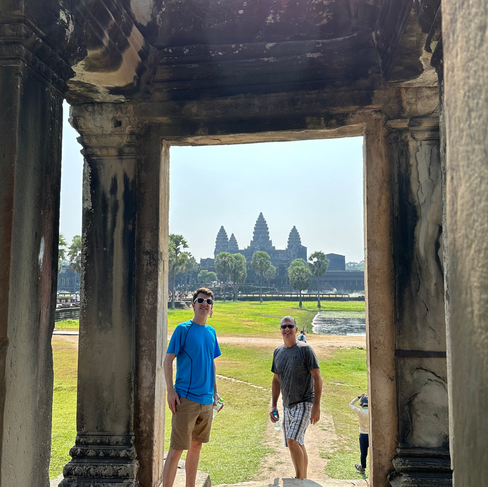
Angkor Wat is a 900-plus year old temple in Siem Reap, Cambodia. It's the largest temple in the Angkor Complex and the largest religious monument in the world. Over 2.6 million people visit every year, and we made the trip to Cambodia to join in and see this incredible architectural wonder.
Built in the early 12th century, the temple didn't get its name Angkor Wat until the 16th century. It was originally called Parama Vishnuloka because it was created as a temple dedicated to the protector god, Vishnu. It has been used as both a Buddhist and Hindu temple, as the Khmer Empire changed religion over time. You can see evidence of this in the removal of buddha carvings in the temple. There are also plenty of statues in the temple that have been decorated and outfitted with shrines. Angkor Wat is still used today: people come to the temple to pray and celebrate.
How was Angkor Wat constructed?
Angkor Wat took 30 years, 300,000 people and 6,000 elephants to construct. The blocks of sandstone and volcanic rock used to construct Angkor Wat were transported by elephants from 25 miles away where they were taken from a quarry in Mount Kulen. The volcanic rock was used for internal structure and the sandstone for the outside since it was better for carving. Since there is nothing holding the stones together (just scored rock and water), everything was carved by hand after the stones were put in place. This part really impressed me because there is just so much of it, the 60-meter-long friezes, the molding, the columns. Everything in Angkor Wat is carved, all by hand!
You can see in some places (the fourth photo) that the carving was never completed. This is just an outline, only the first of many steps needed to go from this to the final product, seen in the second photo. Our guide told us that since the entire complex is now designated as an UNESCO World Heritage Site, finishing this work or repairing any damage is a much more complicated and sometimes impossible project. Also note that the ceiling in red is a reproduction. It was carved from wood, which has rotted and fallen out. I don't believe any original ceiling remains, at least not visible to the public, so this portion was available to give an idea.
Aside from the carving, one of the coolest parts of Angkor Wat is the impressive accuracy of the construction. The entire structure is built perfectly square with the cardinal directions. Our guide showed us with his phone, and you can see the two lines on the left and right separating the stones. This was the very center of the temple, and in every direction, you get perfect views of the long halls and other smaller temples around the temple. It's pretty amazing that this was accomplished in the 12th century, and it makes for some great, well-aligned photos, too.
How big is Angkor Wat?
Angkor Wat is 1.2 km by 1.5 km large and the whole thing is surrounded by a giant moat. The reason for so many moats in the Angkor Complex is that the ground underneath is very loose and mostly sand. If you've ever been to a beach, you know that sand is more stable when wet. The moat around Angkor Wat has been connected to the Siem Reap River in order to make sure it does not dry up. Other temples are in much worse condition because their moats are dry and their foundations unstable. The bridge leading to the main entrance of Angkor Wat just finished renovations after seven years, and you can see the floating bridge used in the interim to the side.
The tallest, central tower of Angkor Wat is almost 700 feet (213 meters) tall. We walked up a series of very steep steps (not the original ones shown below) to get to the top level of Angkor Wat. The views here are great, both of the rest of the temple and the towers.


































